Pull-ups are my favorite exercise of all time.
But what if you can’t do a pull-up yet?
The answer: read this ultimate guide on getting your first pull–up ASAP!
Personal training Toronto have helped hundreds of Online Coaching Clients get their first pull-up, and we’ll cover our exact strategies below!
- Tips on how to start doing pull-ups.
- Level 1 Pull-up Workout: Bent Over Dumbbell Rows
- Level 2 Pull-up Workout: Inverted Bodyweight Rows
- Level 3 Pull-up Workout: Assisted Pull-ups
- Level 4 Pull-up Workout: Top Holds and Bar Hangs
- Level 5 Pull-up Workout: Negative Pull-ups
- Level 6: Doing Your First Pull-up or Chin-Up
- Level 7: Advanced Pull-up Moves
If you can already do a pull-up (woot!), you might want to check out our article on proper pull-up form, although we’ll cover a lot of the same material here.
Let’s do this thang.
Tips on How to Start Doing Pull-Ups
In the video provided above, coach guides you through the precise progression system we employ with our coaching clients who are aiming to achieve their inaugural pull-up (or chin-up).
Before delving into the exercises to advance towards a pull-up, let’s discuss some overall strategies.
Consider these three points as you endeavor to accomplish your first chin-up or pull-up:
1) It’s likely self-evident, but it’s worth stating: the more you weigh, the more weight you’ll need to lift to complete a pull-up.
If you’re genuinely committed to achieving a pull-up, begin by managing your diet.
As we emphasize here at Personal training Toronto, 80-90% of weight loss boils down to your dietary choices.
HERE ARE SOME RESOURCES TO SUPPORT YOU WITH WEIGHT LOSS:
Struggled with weight loss attempts in the past? We understand; weight loss can be incredibly challenging.
Me emphasizing that weight loss fundamentally revolves around consuming fewer calories than you burn. Not sure about your caloric needs? Consult our guide on calculating your daily caloric requirements.
2) PRIORITIZE YOUR “PULL” EXERCISES. Many individuals tend to focus on various exercises before addressing back-related exercises, or they may skip them altogether.
After a proper warm-up, always begin with the exercises you’re most eager to improve – in this case, it’s your back muscles.
Until you accomplish your initial pull-up, concentrate on the back exercises outlined in the levels and workouts provided in this guide.
3) The progression we’ve outlined is a route that proves effective for most individuals but is NOT a rigid prescription.
We offer sample sets and reps, along with guidance on when to progress, but if you feel you’re ready to progress sooner or attempt full pull-ups earlier than our recommendation, that’s absolutely FINE.
This is a gradual progression approach, and some may choose to perform fewer reps and advance to the next levels more swiftly – that’s perfectly acceptable.
We suggest advancing to the next level once you can perform 3 sets of 8 reps for a particular exercise. If you prefer a more accelerated approach, move up as soon as you can complete 3 sets of 5 reps. Tailor the progression to suit you.
You can follow our suggested path for achieving a pull-up, but don’t hesitate to adapt it to your preferences!
Seeking a personalized progression plan to achieve your first pull-up? Our 1-on-1 Online Coaching Program is designed for precisely that purpose. Your dedicated coach can craft a customized plan for you and review your movements through our app, ensuring you’re training accurately and safely.
Level 1 Pull-up Workout: Bent Over Dumbbell Rows
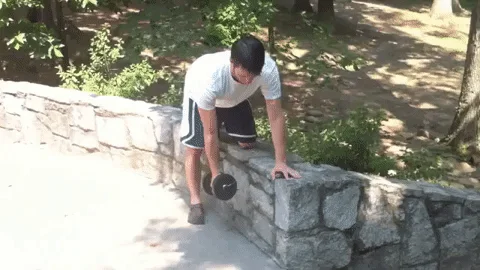
We’re going to start with bent-over dumbbell rows, the most basic of back exercises, in case you’re starting from ABSOLUTELY square one.
Level 1 Pull-up Workout:
- Bent-over dumbbell rows: 8 reps for each arm (or as many as you can do)
- Rest for a 2-minute break
- Do another set
- Repeat until you hit 3 sets
What weight should you start out with initially?
Whatever allows you to get to at least 5 reps a set.
Once you can do 3 sets of 8 reps (each arm), it’s time to pick up a heavier dumbbell.
This will allow you to get stronger and stronger.
Make sure you give yourself at least 48 hours until you do the Level 1 Dumbbell Rows again, so you can include these dumbbell rows for your workouts on:
- Monday
- Wednesday
- Friday
As soon as you can do 3 sets of 8 reps, it’s time to move up to a heavier dumbbell.
- Once you can lift a 25-pound (10kg) dumbbell or heavier, consider moving up to the next level.
- If you are a little bit bigger than the average bear, you might want to stick with this step until you lose a little bit more weight and get stronger – maybe go to 35 or 40-pound (18kg) dumbbells.
Want help designing your own workout routine? I’ve got two options for you.
The first is to head over to “Build Your Own Workout Routine” and get your hands dirty. Our guide will walk you through building a full-body exercise program in 10 simple steps.
Level 2 Pull-Up Workout: Inverted Bodyweight Rows

Bodyweight rows serve as an excellent precursor to pull-ups, engaging the same muscle groups while allowing you to lift your body weight from a different perspective.
At this stage, we present two options and room for adjustments:
OPTION A: FOR THOSE WITH GYM ACCESS OR INTERESTED IN JOINING A GYM:
You can seamlessly integrate this workout into our 6-Level Gym workout guide, propelling you from a gym newcomer to a pull-up progress virtuoso!
A higher bar facilitates an easier start.
And as your strength improves, feel free to lower the bar.
HERE’S A STEP-BY-STEP GUIDE TO INVERTED BODYWEIGHT ROWS:
- Adjust the bar to a height that challenges you to complete 3 sets of 8 reps with a two-minute rest interval between sets.
- Engage your glutes, tighten your abs, and maintain a straight body position throughout the exercise.
- Draw your shoulder blades downward and backward, envisioning pinching a pencil between them behind your back.
- Concentrate on the pulling motion with your arms.
- Pull until your chest connects with the bar, avoiding contact with your neck.
- Once you can successfully complete 3 sets of 8 reps, lower the bar height to intensify the exercise.
If you need to lessen the difficulty of the exercise, bend your knees and place your feet flat on the ground.

Level 2 Workout Routine Overview:
- Monday – Perform 3 sets of 8 reps of overhand bodyweight rows.
- Wednesday – Complete 3 sets of 8 reps of underhand bodyweight rows (reversed hand position).
- Friday – Execute 3 sets of 8 reps of overhand bodyweight rows.
(Next week, alternate between underhand, overhand, and underhand grip.)
Once you can perform bodyweight rows at a 45-degree angle or lower, you’re ready to advance to Level 3.
OPTION B: IF GYM ACCESS IS UNAVAILABLE FOR INVERTED ROWS:
You have several options to consider:
- Acquire a pull-up bar that fits into a door frame, hang gymnastic rings, and apply the same approach as mentioned above.
- Use your kitchen table for performing rows (exercise caution).
- Utilize a pair of chairs to perform inverted rows, following the guidelines outlined in our article “How to Do Pull-ups Without a Bar.”
- Progress cautiously to Level 3.
If you’re encountering difficulties with rows, unsure about correct form, or uncertain about how to proceed to the next level, our 1-on-1 coaching program can provide guidance and support.
Level 3 Pull-Up Workout: Assisted Pull-Ups
Okay! It’s time to get to ACTUAL pull-ups here! Personally, I don’t like using the assisted pull-up machine in a gym as it doesn’t give you the full feeling of a pull-up, but it’s certainly better than nothing.
Instead, I recommend doing one of these alternatives:
1) Assisted Pull-ups with a chair
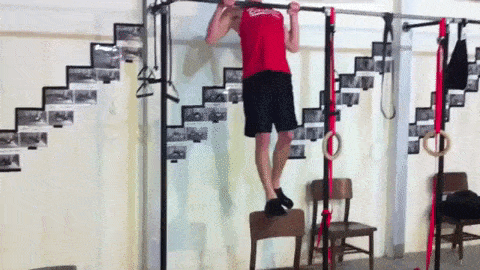
Either one foot or two on the chair, depending on your needs. Your feet are ONLY there for support, use your upper body as much as possible.
You can also use a box or similar-sized object for the same result:
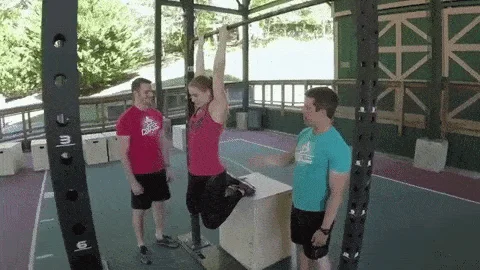
2)Assisted Pull-ups with exercise band:
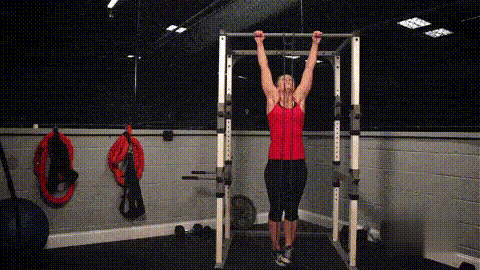
You can get different types of exercise bands with different levels of strength, or a variety pack for easy progression.
Put your foot in the exercise band and pull yourself up.
3) Assisted pull-ups with a partner:
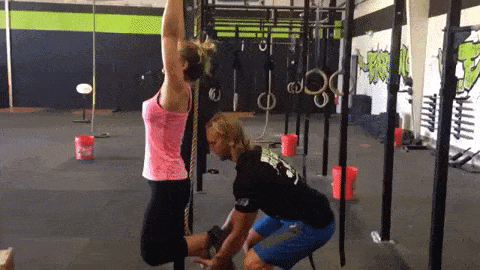
Have a friend hold your feet behind you and help you complete each rep. Have them use the least amount of help possible to get you through your workouts.
HERE’S HOW TO DO AN ASSISTED PULL-UP:
- Clench your butt and keep your abs tight throughout the exercise – try not to swing like crazy.
- Keep your shoulder blades pinched behind you throughout the movement and focus on PULLING the bar down with your arms.
- Use the least amount of assistance that you can handle – as soon as you can do multiple pull-ups with both feet on the chair, switch to just one foot.
- If you’re using an exercise band, try to get a few bands of varying tension so you can decrease the resistance as you get stronger.
- As soon as you can do 3 sets of 8 with assistance, it’s time to move on to Level 4.
This is probably the TOUGHEST level before getting your pull-ups. If you get stuck on “assisted pull-ups” and “assisted chin-ups”, you’re not alone. This is where most people get stuck.
We work hand-in-hand with people like you to get them their first pull-up in our Online Coaching Program. If you don’t know how to fit these movements into your workouts, or you just want somebody to give you the exact workout to follow every day, we got you!
Finally, a workout that includes Level 3 pull-up exercises
- Monday – Assisted Pull-ups – 3 sets of 8 reps
- Wednesday – Inverted Bodyweight Rows – 3 sets of 8 reps
- Friday – Assisted Chin Ups – 3 sets of 8 reps
This will help you ramp up to Level 4.
Level 4 Pull-Up Workout: Top holds and Bar Hangs

Great start! We’ve made excellent progress by focusing on those pulling muscles and assisted variations. However, achieving an actual chin-up might seem like a distant goal at this point.
In fact, simply holding onto the bar could be challenging without some assistance. So, what’s the next step?
How about we concentrate on mastering the art of holding onto the bar!?!
Before we embark on the journey of executing full range, unassisted chin-ups or pull-ups, it’s crucial to build strength and confidence in holding unassisted positions during the movement.
This is where Top Holds and Bar Hangs become valuable!
1) A Top Hold entails holding the top position of a chin-up or pull-up for several seconds (around 5 to 10 seconds). Generally, holding the top of a chin-up (palms facing you) is easier than a pull-up.
It’s advisable to start with assistance for this exercise. Over the course of several workouts, we’ll gradually transfer more weight from our feet to our arms until we can hold the top position unassisted.
Using a band is a good option for assisted chin-ups, but employing a box, bench, or another sturdy object might be a better choice here. It’ll help distribute your weight onto your arms more effectively.
However, if all you have is a band for this exercise, that’s perfectly fine! Aim to use thinner bands and lift your feet and knees slightly to reduce assistance further (as the band won’t be stretched as far).
2) On the flip side, we have the Bar Hang – quite self-explanatory!
To perform a bar hang:
- Grab the bar with palms facing towards you or away from you. You might find hanging with palms facing away to be more comfortable. Either direction will help improve your grip strength.
- Similar to the top hold, begin with assistance and gradually shift your weight from your feet to your arms until you can hang unassisted.
To maximize this exercise: once you achieve an unassisted hang, focus on retracting your shoulders downward away from your ears.
This slight movement is challenging (you can even practice it assisted), but gaining strength here will position your shoulders better for your initial chin-up/pull-up.
Our aim is to accumulate a total time of 30 seconds to 1 minute hanging from the bar (assisted or unassisted). Initially, this time may be divided into several sets (e.g., 10 seconds, 10 seconds, 10 seconds), but eventually, aim for one continuous set.
So, how should we incorporate these exercises into our training?
1) For the Top Holds, incorporate them at the beginning of your workout (after warming up) with 3 sets of 5 seconds each. Give it your all! Squeeze your muscles tight and put as much weight on your arms as possible during these 5 seconds!
After such exertion, give yourself a rest of 30 seconds to a minute between sets. It might sound like a lot for just 5 seconds of work, but if you pushed yourself, you’ll need it!
2) For the Bar Hang, do this at the end of your workout for 30 seconds to a minute. Aim to complete this in as few sets as possible, making the exercise as challenging as you can. Transition from assisted to unassisted, keeping your shoulders retracted downward.
If you need to take a break during the bar hang, ensure it’s enough for the subsequent hold to be productive.
Here are the exercises to include in your Level 4 Workout Routine:
Monday:
- Top Hold (Assisted or Unassisted) – 4 sets of 5 seconds
- Assisted Pull-ups – 3 sets of 8 repetitions
Bar Hang (Assisted or Unassisted) – 30 seconds total time
Wednesday:
- Top Hold (Assisted or Unassisted) – 4 sets of 5-10 seconds
- Bodyweight Rows – 3 sets of 8 reps
- Bar Hang (Assisted or Unassisted) – 30 to 60 seconds total time
Friday:
- Top Hold (Assisted or Unassisted) – 4 sets of 5 seconds
- Assisted Chin-ups – 3 sets of 8 reps
- Bar Hang (Assisted or Unassisted) – 30 seconds total time
Once you can perform Top Holds and Bar Hangs unassisted, it’s time to progress to the next level!
LEVEL 4.5 PULL-UP WORKOUT: (THE HIDDEN LEVEL)

What’s this??? Secret hidden exercises?
I just wanted to bring your attention to a great addition to any of these workouts – especially as things really ramp up.
Ready for it?
It’s . . . the front plank!
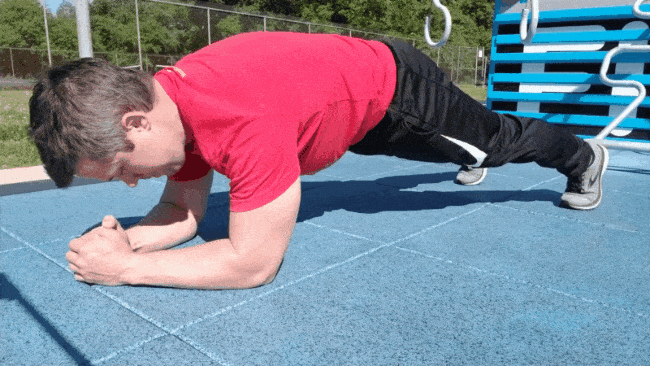
The front plank (or any of your favorite midsection stabilization exercises) is a great exercise to do, should holding a Top Hold or a Bar Hang prove tough.
If you haven’t already felt it during the previous pull-up workouts – your middle needs to be involved too!
During a pull-up or chin-up, if we squeeze through the midsection and glutes, the nearby muscles are able to contract stronger through a phenomenon known as muscle irradiation.
Besides sounding like something the Fantastic Four encountered in space, this cool “trick” can help engaged nearby muscles in the midsection, including those big back muscles that pull us up!
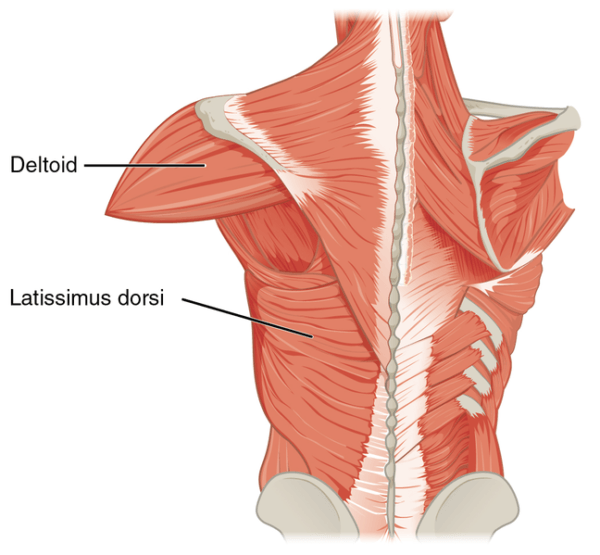
You can see muscle irradiation for yourself if you’ve ever been asked to flex your biceps for someone. You’ll instinctually squeeze your hand tight, because it helps the biceps engage stronger!
If needed, throw in some front planks work near the end of your workout.
Level 5 Pull-Up Workout: Negative Pull-Ups
Alright! We are now extremely close to achieving our first pull-up!
The significant milestone at this level is performing a negative pull-up:
- Grip the bar with an overhand grip.
- Jump so that your chest is touching the bar.
- Slowly and in a controlled manner, lower yourself until you reach the bottom of the movement.
WARNING: This can pose a significant risk if you’re considerably overweight. Hence, I recommend progressing cautiously through steps 1-3 initially.
However, once you have developed a reasonable amount of back strength (acquired from Levels 1, 2, and 3), negative pull-ups become an excellent way to enhance arm and back strength.
You have two options for negative pull-ups:
- Use a chair to elevate yourself above the bar and then lower yourself back down, maintaining control throughout. The key is to be “in control.”
- Jump above the pull-up bar and then initiate a controlled descent back down.
You don’t need to lower yourself at an excessively slow pace, causing each repetition to be overly taxing. Lower yourself at a controlled speed – counting to “three Mississippi” during the movement provides a good tempo.
Here are the exercises you can incorporate into your Level 5 Workout Routine:
Monday:
- Negative Pull-ups – 4 sets of 1 rep
- Assisted Pull-ups – 3 sets of 8 reps
- Bar Hang (Unassisted) – 30 seconds total time
Wednesday:
- Top Hold (Unassisted) – 4 sets of 5-10 seconds
- Bodyweight Rows – 3 sets of 8 reps
- Bar Hang (Unassisted) – 60 seconds total time
Friday:
- Negative Chin-ups – 4 sets of 1 rep
- Assisted Chin-ups – 3 sets of 8 reps
- Bar Hang (Unassisted) – 30 seconds total time
Once you can successfully complete all the negative repetitions in each exercise, you’re primed to perform a pull-up.
As indicated above, we’ve outlined the “pull” exercises for those creating their own workout. If you’re seeking a beginner gym workout program, these movements will seamlessly integrate.
Level 6 – Doing Your First Pull-up or Chin-up
OH BOY! My dear Rebel, it’s time for a…
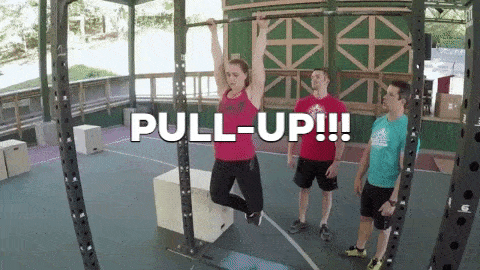
At this point you have two options:
A chin-up is when you grab the bar with an underhand grip with your palms facing towards you.
Many find chin-ups slightly easier than…
A pull-up is when you grab the bar with your palms facing away from you. Seeing as this is a pull-up guide…
HOW TO DO A PULL-UP, STEP-BY-STEP:
- Grab the bar with a grip slightly wider than shoulder-width, with your hands facing away from you.
- Start from a dead hang.
- Engage your shoulders, pull them down and back towards each other (like you are pinching a pencil between your shoulder blades!)
- Flex your stomach, pull your body until your chest touches the bar.
- Slight pause, yell out “I’m a champion!”
- Lower yourself all the way back down to a dead hang.
Depending on your weight, your level of fitness and strength, and how far along you are in these progressions, you might be able to start with even more than one pull-up.
At this point, you can be a full Gym Class Hero by following a Gym Workout with these movements in there for your “pull” exercises:
Level 6 routine weekly schedule:
Monday:
- Pull-ups – 4 sets of 1-2 reps (move onto the next exercise if you can’t perform a rep)
- Assisted Pull-ups – 3 sets of 8 reps
- Bar Hang (Unassisted) – 60 seconds total time
Wednesday:
- Negative Chin-ups – 4 sets of 1 rep
- Bodyweight Rows – 3 sets of 8 reps
- Bar Hang (Unassisted) – 60 seconds total time
Friday:
- Chin-ups – 4 sets of 1-2 reps (move onto the next exercise if you can’t perform a rep)
- Assisted Chin-ups – 3 sets of 8 reps
- Bar Hang (Unassisted) – 60 seconds total time
Congratulations! You’re now doing pull-ups. Make sure you watch that video above to make sure you’re doing pull-ups with proper form. Nearly everybody does them incorrectly, with bad form.
Want to make sure you have proper form with your pull-ups? Check out our 1-on-1 Coaching program! Our spiffy mobile app lets you send video of your pull-ups directly to your coach, who will provide feedback so you can perfect your technique.
They’ll also build a workout program that’s custom to your situation, which will have you doing sets of 10 pull-ups in NO time!
Level 7 – Advanced Pull-up Moves
Once you achieve the capability to perform 3 sets of 10 pull-ups or chin-ups, you have several pathways to consider:
OPTION A: Progressing Reps
Continue enhancing your performance by increasing the number of repetitions: 3 sets of 12, 3 sets of 15, 4 sets of 20, and so on.
OPTION B: Explore Different Pull-Ups
Begin incorporating various types of pull-ups.
Here are some advanced pull-ups you can experiment with:
1) WIDE GRIP PULL-UPS (grasp the bar with a considerably wider grip using both hands):
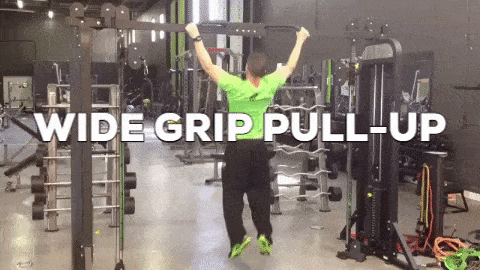
2) SIDE TO SIDE PULL-UPS

3) RING PULL-UPS
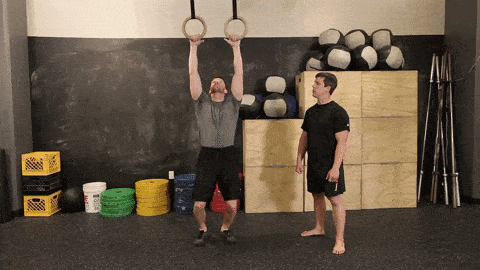
4) Incorporate Additional Weight
Utilize a weight belt to add extra weight and engage in weighted pull-ups or weighted chin-ups:
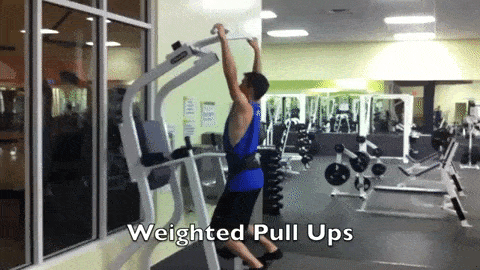
From my perspective, one of the gym activities I truly enjoy is engaging in weighted pull-ups. If you find yourself at this level and aspire to try them, here’s how you can go about it:
- Get a Weight Belt: Acquire a weight belt; personally, I purchased one from Amazon and it has proven to be highly effective for me. While using weights in a backpack is an option, it can feel awkward due to the angle of the weights hanging off your back. With a weight belt, the weight hangs down between your legs, providing a more natural feel.
- Gradually Increase Weight: Begin by adding small amounts of weight at a time. Most gyms offer 2.5 lb (approximately 1 kg) weights. Even though you might feel a bit odd putting on a weight belt and hanging a small weight, everyone starts somewhere and it’s important to begin with manageable weights.
- Consistently Ramp Up Weight: Start with two sets of 5 pull-ups without any extra weight as part of your warm-up. Then, proceed to complete 3 sets of 5 weighted pull-ups. If you successfully finish all 3 sets with 5 reps each (ensuring your chin goes over the bar for every rep), make a note to add 2.5 or 5 lbs (1 or 2 kg) to your weight belt for the next session.
Here’s a guide on integrating these Level 6 exercises into your gym routine:
- Monday: Weighted Chin Ups – 3 sets of 5 reps
- Wednesday: Elevated Feet Body Weight Rows – 3 sets of maximum repetitions
- Friday: Wide Grip Pull-ups – 3 sets of maximum repetitions
- (In the following week, you can alternate by doing chin-ups without weight and then incorporating weighted pull-ups).
Lift Yourself Up (A Life With Pull-Ups)
No matter your starting point, you CAN do pull-ups.
And you WILL do pull-ups with this guide.
You don’t need to follow the progression above exactly – it’s merely one path that you can take in order to reach the promised land…where the pull-ups flow like wine and the women instinctively flock like the Salmon of Capistrano.

